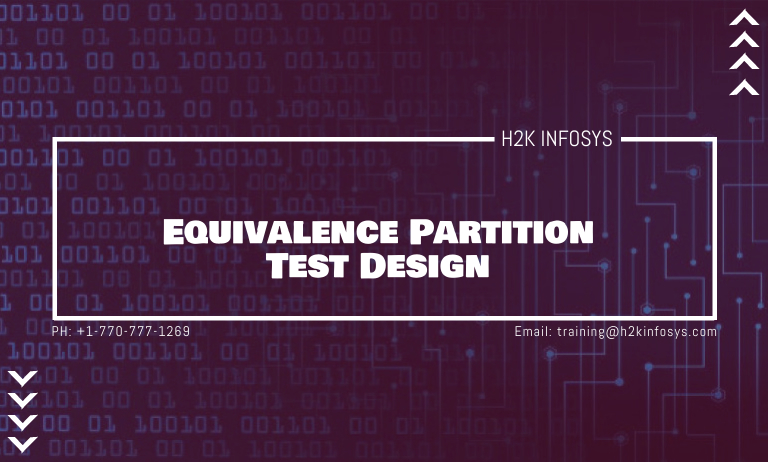What is Equivalence Partition Test Design?
Equivalence partitioning also called as equivalence class partitioning. It is also called as ECP. It is a software testing design technique that divides the input test data of the software under test into different partitions. Each partition is a set of similar data elements, and one test data value from each partition represents the whole partition. A minimum of equivalent data from which test cases can be derived.
An advantage of this approach is it reduces the time required for performing testing of software for less number of test cases.
For example,
The below example best describes the equivalence class partitioning:
Assume that the application accepts an integer in the range 200 to 999.
- Valid Equivalence class partition: 200 to 999 inclusive.
- In-valid equivalence class partition: less than 200, more than 999, decimal numbers and alphabets/non-numeric characters.
Equivalence Partition test is also known as Equivalence partitioning which is an important software testing technique used by the team of testers for the partitioning of the input data, which is then used for the aim of testing the software package into a variety of classes. These different classes resemble the required requirements and customary behavior of the aggregated inputs. Therefore the tests are designed and created based on each class attribute and one element or input.
The following guidelines for equivalence partitioning:
- If the condition in range is given as input, then one valid and we have two invalid equivalences classes are defined.
- If a specific value is given as input, then one valid and two invalid equivalence classes are defined.
- If a member of a group is given as an input then one valid and one invalid equivalence class is defined.
- If Boolean number is given as an input condition then one valid and invalid equivalence class is defined.
For example:
We shall consider an example of any college admission process. Consider a college that gives the admissions to students based upon their percentage.
Consider the percentage field which will accept percentage between 50% to 90%. More and even less than range will be not be accepted and application will automatically redirect the user to error page. If the percentage entered is between 50% to 90% then equivalence partitioning method will show valid percentage.
Equivalence partitioning is also called equivalence class partitioning. In this partitioning the inputs to the software or system are divided into groups that are expected to exhibit similar behaviour, so they are likely to be proposed in the same way.
How to design test case in this testing?
Consider a mobile number which has 10 digits
Valid input digits are 10 Invalid input 9 to 11 digits Valid class: Enter 10 digit mobile number = 4406565401 Invalid class Enter mobile which has less than 10 digits = 614344210 Invalid class more than 11 digits are = 51365421012
When designing test cases for the software, we can make sure that the three valid equivalence partitions are covered and we would also test the invalid equivalence partition at least once. For example, we may choose to calculate the interest balances of -$10.00, $50.00, $260.00 and $1348.00. If we did not identify the partitions, it is possible that at least one of them could have been missed at the expense of testing another one several times. Similarly, we can apply equivalence partitioning to outputs as well. In this case, we have three interests rate: 3%, 5% and 7% plus the error. The output partitions line up exactly with the input partitions.































18 Responses
Equivalence Partition Test Design:
testing design technique that divides the input test data of the software under test into different partitions. Each partition is a set of similar data elements, and one test data value from each partition represents the whole partition. A minimum of equivalent data from which test cases can be derived.
An advantage of this approach is it reduces the time required for performing testing of software for less number of test cases.
For example,
Valid Equivalence class partition: 200 to 999 inclusive.
In-valid equivalence class partition: less than 200, more than 999, decimal numbers and alphabets/non-numeric characters.
The following guidelines for equivalence partitioning:
-If the condition in range is given as input, then one valid and we have two invalid equivalences classes are defined.
-If a specific value is given as input, then one valid and two invalid equivalence classes are defined.
-If a member of a group is given as an input then one valid and one invalid equivalence class is defined.
-If Boolean number is given as an input condition then one valid and invalid equivalence class is defined.
Equivalence partitioning is also called equivalence class partitioning. In this partitioning the inputs to the software or system are divided into groups that are expected to exhibit similar behaviour, so they are likely to be proposed in the same way.
How to design Test case in testing:
When designing test cases for the software, we can make sure that the three valid equivalence partitions are covered and we would also test the invalid equivalence partition at least once. For example, we may choose to calculate the interest balances of -$10.00, $50.00, $260.00 and $1348.00. If we did not identify the partitions, it is possible that at least one of them could have been missed at the expense of testing another one several times. Similarly, we can apply equivalence partitioning to outputs as well. In this case, we have three interests rate: 3%, 5% and 7% plus the error. The output partitions line up exactly with the input partitions.
Equivalence Partition Test Design:
Equivalence partitioning also called as equivalence class partitioning. It is also called as ECP. It is a software testing design technique that divides the input test data of the software under test into different partitions. Each partition is a set of similar data elements, and one test data value from each partition represents the whole partition. A minimum of equivalent data from which test cases can be derived.
Equivalence Partition test is also known as Equivalence partitioning which is an important software testing technique used by the team of testers for the partitioning of the input data, which is then used for the aim of testing the software package into a variety of classes.
The following guidelines for equivalence partitioning:
1. If the condition in range is given as input, then one valid and we have two invalid equivalences classes are defined.
2. If a specific value is given as input, then one valid and two invalid equivalence classes are defined.
3. If a member of a group is given as an input then one valid and one invalid equivalence class is defined.
4. If Boolean number is given as an input condition then one valid and invalid equivalence class is defined.
Equivalence Class Partition is one of the testing technique where paritions are created in order to ensure that the input types are covered under different class partitions.
partitions are based on input conditions:
– range of values as input – one valid and two invalid equivalences classes are defined.
– specific value as input – one valid and one invalid equivalence classes are defined.
– group is given as an input – one valid and two or more invalid equivalence class is defined (in case of alphabets, the special characters and blanks are considerd invalid.
– Boolean number is given as an input – one valid and invalid equivalence class is defined.
Equivalence Partition Test Design
Equivalence Partition is also known as Equivalence Class Partition (EVP). It is a software test design technique that divides the input data into different partitions which is under test.
The advantage in EVP technique reduce the time require and with possible limit number of test case.
For eg: 200 to 999
the input partition will be 999
ECP is a software testing design technique that divides the input test data of the software under test into different partitions. it is used by team of testers for the portioning of the input data which is then used by the team of testers for the aim of testing the software package into variety of classes.
Guidelines for ECP
– if the condition in range is given as input, then one valid and we have invalid equivalences classes are defined
_ if a member of a group is given as an input then tone valid and one invalid equivalence is defined
-if boolen number is given as an input condition then one valid and invalid equivalence class ins defined
This document describes what is Equivalence Partition Test Design.
Equivalence partitioning also called as equivalence class partitioning. It is also called as ECP. It is a software testing design technique that divides the input test data of the software under test into different partitions. Each partition is a set of similar data elements, and one test data value from each partition represents the whole partition. A minimum of equivalent data from which test cases can be derived.
An advantage of this approach is it reduces the time required for performing testing of software for less number of test cases.
For example,
The below example best describes the equivalence class partitioning:
Assume that the application accepts an integer in the range 200 to 999.
Valid Equivalence class partition: 200 to 999 inclusive.
In-valid equivalence class partition: less than 200, more than 999, decimal numbers and alphabets/non-numeric characters.
Equivalence Partition test is also known as Equivalence partitioning which is an important software testing technique used by the team of testers for the partitioning of the input data, which is then used for the aim of testing the software package into a variety of classes. These different classes resemble the required requirements and customary behavior of the aggregated inputs. Therefore the tests are designed and created based on each class attribute and one element or input.
The following guidelines for equivalence partitioning:
If the condition in range is given as input, then one valid and we have two invalid equivalences classes are defined.
If a specific value is given as input, then one valid and two invalid equivalence classes are defined.
If a member of a group is given as an input then one valid and one invalid equivalence class is defined.
If Boolean number is given as an input condition then one valid and invalid equivalence class is defined.
Equivalence partitioning is also called equivalence class partitioning. In this partitioning the inputs to the software or system are divided into groups that are expected to exhibit similar behavior, so they are likely to be proposed in the same way.
Equivalence partitioning ( ECP) is a testing technique that divide input data of software into different equivalence data classes. it reduces the time required for testing because of small numbers of testing cases . Hypothesis behind this technique is that if one condition in a partition passes all other will also pass & if one condition in partition fails , all other condition in that partition will also fail.
Here we see,
What is Equivalence Partition Test Design?
How to Perform Equivalence Partition test?
How to design Test Case for Equivalence Partition testing?
Equivalence partitioning is one of software testing technique it divides the input test data under test into different partitions.
advantage of this technique we can reduce the time required for testing for less number of test cases.
-if the range is given as input ,then one valid and two invalid equivalence classes are defines.
-if the value is given as input ,then one valid and two invalid equivalence classes are defines.
-if the range is given as input ,then one valid and two in valid equivalence classes are defines.
-if the member of group is given as input ,then one valid and one invalid equivalence classes are defines.
-if the Boolean is given as input ,then one valid and one invalid equivalence classes are defines.
how to design test case write valid input and invalid input and valid class and data (if the requirement is number we can write like this)
Equivalence partitioning also called as equivalence class partitioning is a software testing design technique that divides the input test data of the software under test into different partitions. Each partition is a set of similar data elements, and one test data value from each partition represents the whole partition. A minimum of equivalent data from which test cases can be derived.
An advantage of this kind of method is it requires less number of test cases to test the software accurately.
For example,
The below example best describes the equivalence class partitioning:
Assume that the application accepts an integer in the range 200 to 999.
Valid Equivalence class partition: 200 to 999 inclusive.
In-valid equivalence class partition: less than 200, more than 999, decimal numbers and alphabets/non-numeric characters.
Equivalence Partition test is used by the team of testers for the partitioning of the input data, which is then used for the aim of testing the software package into a variety of classes. These different classes resemble the required requirements and customary behavior of the aggregated inputs. Therefore the tests are designed and created based on each class attribute and one element or input.
The following guidelines for equivalence partitioning:
1)If the condition in range is given as input, then one valid and we have two invalid equivalences classes are defined.
2)If a specific value is given as input, then one valid and two invalid equivalence classes are defined.
3)If a member of a group is given as an input then one valid and one invalid equivalence class is defined.
4)If Boolean number is given as an input condition then one valid and invalid equivalence class is defined.
An advantage of equivalence class partitioning (also called as ECP) approach is it reduces the time required for performing testing of software for less number of test cases. Also known as Equivalence partitioning software testing technique used by the team of testers for the partitioning of the input data, which is then used for the aim of testing the software package into a variety of classes.
The Equivalence partitioning guideline are;
If the condition in range is given as input, then one valid and we have two invalid equivalences classes are defined.
If a specific value is given as input, then one valid and two invalid equivalence classes are defined.
If a member of a group is given as an input then one valid and one invalid equivalence class is defined.
If Boolean number is given as an input condition then one valid and invalid equivalence class is defined.
Also in equivalence class partitioning the inputs to the software or system are divided into groups that are expected to exhibit similar behaviour, so they are likely to be proposed in the same way.
Equivalence Partition Test Design:
Equivalence partitioning also called as equivalence class partitioning. It is also called as ECP. It is a software testing design technique that divides the input test data of the software under test into different partitions. Each partition is a set of similar data elements, and one test data value from each partition represents the whole partition. A minimum of equivalent data from which test cases can be derived.
Equivalence Partition test is also known as Equivalence partitioning which is an important software testing technique used by the team of testers for the partitioning of the input data, which is then used for the aim of testing the software package into a variety of classes.
The following guidelines for equivalence partitioning:
1. If the condition in range is given as input, then one valid and we have two invalid equivalences classes are defined.
2. If a specific value is given as input, then one valid and two invalid equivalence classes are defined.
3. If a member of a group is given as an input then one valid and one invalid equivalence class is defined.
4. If Boolean number is given as an input condition then one valid and invalid equivalence class is defined.
Equivalence partitioning also called as equivalence class partitioning. It is also called as ECP. It is a software testing design technique that divides the input test data of the software under test into different partitions. Each partition is a set of similar data elements, and one test data value from each partition represents the whole partition. A minimum of equivalent data from which test cases can be derived.
An advantage of this approach is it reduces the time required for performing testing of software for less number of test cases.
Equivalence Partition test is also known as Equivalence partitioning which is an important software testing technique used by the team of testers for the partitioning of the input data, which is then used for the aim of testing the software package into a variety of classes. These different classes resemble the required requirements and customary behavior of the aggregated inputs. Therefore the tests are designed and created based on each class attribute and one element or input.
Equivalence partitioning It is a software testing design technique that divides the input test data of the software under test into different partitions. Each partition is a set of similar data elements, and one test data value from each partition represents the whole partition. A minimum of equivalent data from which test cases can be derived.
Equivalence partitioning also called as equivalence class partitioning. It is also called as ECP. It is a software testing design technique that divides the input test data of the software under test into different partitions. Each partition is a set of similar data elements, and one test data value from each partition represents the whole partition. A minimum of equivalent data from which test cases can be derived.
An advantage of this approach is it reduces the time required for performing testing of software for less number of test cases.
Equivalence partitioning also called as equivalence class partitioning or ECP. It is a software testing design technique that divides the input test data of the software under test into different partitions. Each partition is a set of similar data elements, and one test data value from each partition represents the whole partition. A minimum of equivalent data from which test cases can be derived. An advantage of this approach is it reduces the time required for performing testing of software for less number of test cases.
Input data is used for the aim of testing the software package into variety of classes. Different classes resemble the required requirements and customary behavior of the aggregated inputs. Therefore the tests are designed and created based on each class attribute and one element or input.
Guidelines for ECP are:
-If the condition in range is given as input, then one valid and we have two invalid equivalences classes are defined.
-If a specific value is given as input, then one valid and two invalid equivalence classes are defined.
-If a member of a group is given as an input then one valid and one invalid equivalence class is defined.
-If Boolean number is given as an input condition then one valid and invalid equivalence class is defined.
Equivalence Partition Test design(ECP)
ECP is a software Technique that divides the input data of a software unit into partitions of equivalent data from which test cases are derived. In ECP test cases are designed to cover each partionion at leat once.
An advantage of this approach is it reduces the time required for performing testing of software for less number of test cases.
Equivalence partitioning also called as equivalence class partitioning. It is also called as ECP. It is a software testing design technique that divides the input test data of the software under test into different partitions. Each partition is a set of similar data elements, and one test data value from each partition represents the whole partition. A minimum of equivalent data from which test cases can be derived.
An advantage of this approach is it reduces the time required for performing testing of software for less number of test cases.
Equivalence Partition test is also known as Equivalence partitioning which is an important software testing technique used by the team of testers for the partitioning of the input data, which is then used for the aim of testing the software package into a variety of classes. These different classes resemble the required requirements and customary behavior of the aggregated inputs. Therefore the tests are designed and created based on each class attribute and one element or input.
The following guidelines for equivalence partitioning:
If the condition in range is given as input, then one valid and we have two invalid equivalences classes are defined.
If a specific value is given as input, then one valid and two invalid equivalence classes are defined.
If a member of a group is given as an input then one valid and one invalid equivalence class is defined.
If Boolean number is given as an input condition then one valid and invalid equivalence class is defined.
Equivalence partitioning is also called equivalence class partitioning. In this partitioning the inputs to the software or system are divided into groups that are expected to exhibit similar behavior, so they are likely to be proposed in the same way.